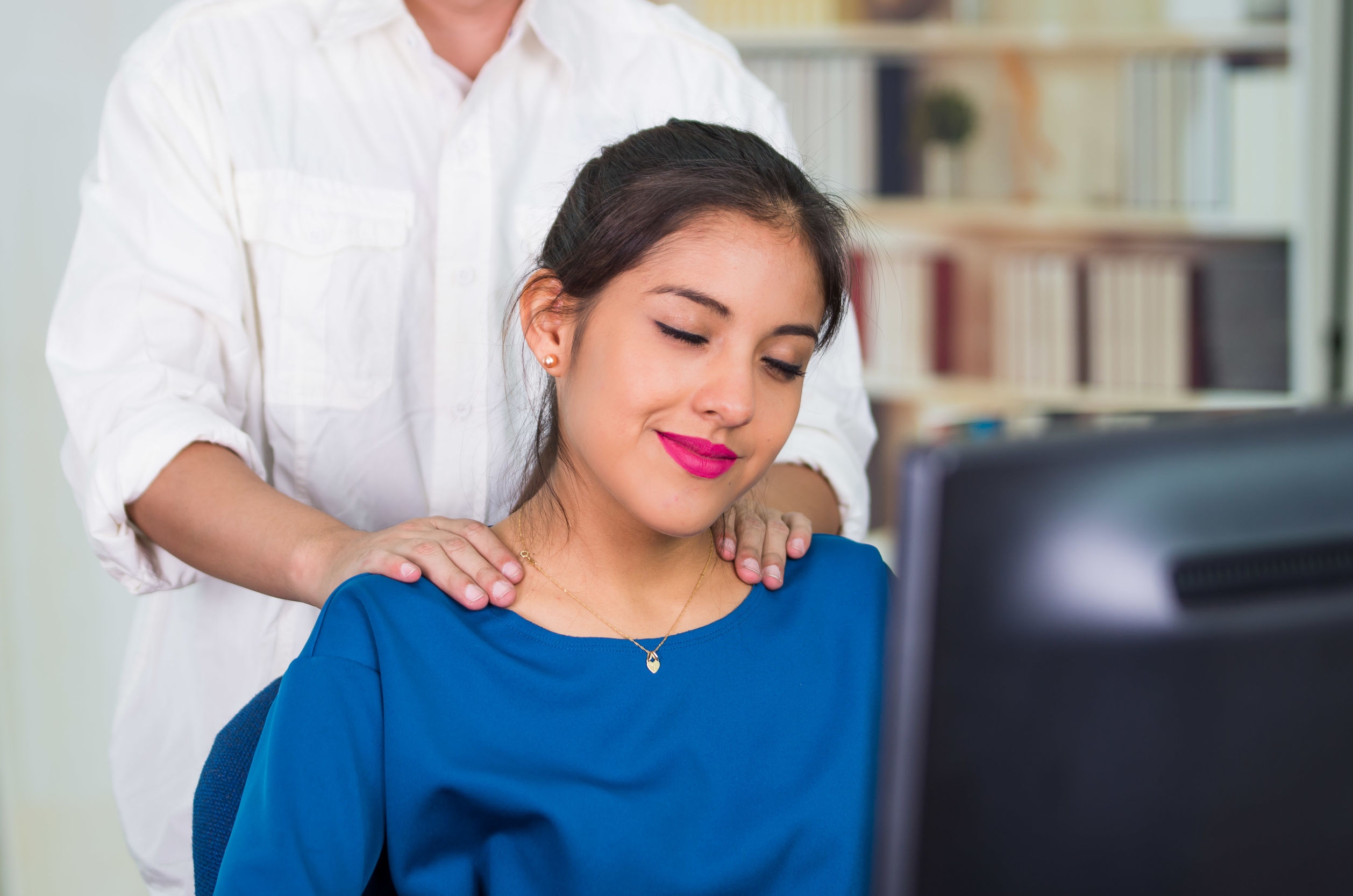Desk massage treatments are becoming increasingly popular among busy offices due to the flexibility of the treatment. Typically quicker than seated chair massage, it allows for more people to be treated. This makes desk massage an extremely cost effective addition to employee benefits programs and is an effective way to help manage workplace stress. Seated desk massages mean your staff can feel refreshed and revitalised, without even having to leave their workstation.
Desk Massage Quick Facts
- Duration: The treatment length can be whatever you feel is suitable for your workforce, most common treatment lengths are 15 or 20 minutes long
- Body Parts Treated: Head,Neck and Shoulders
- Techniques used: All the five classic movements may be incorporated in a desk massage treatment: effleurage, petrissage, tapotement, friction and vibration
- Equipment: Wet wipes and antibacterial gel for the therapist to clean their hands in- between treatments.
Dictionary Definition
There is no definition for Desk Massage in the dictionary. However 'at-desk' is listed in the Collins dictionary as:
Adjective - Carried out at a person’s desk at his or her place of work.
What is desk massage?
Desk massages are massage treatments provided to an individual at their desk in their work chair. This allows minimal disruption to the working day. Typically the shoulders, neck and head are massaged in the normal seated position. The massage is done through the clothes and does not require oils. Desk massages are most popular in office environments where it's not convenient for staff to leave their work station. A typical treatment length is 15 - 20 minutes long.
What to expect from a desk massage treatment?
All massage treatments begin with a short safety check to ensure that you are fit and well. You will be asked to complete a safety form and highlight any relevant health issues to your therapist. Please let your therapist know if you have any particular areas of tension that you would like given special attention.
The therapist will provide the massage treatment at your workstation in your chair. You will be asked to sit back against the chair backrest and take in a slow deep breath. As you breathe out, relax and let the shoulders drop. Your eyes can remain open or be closed to suit you. Concentrate on a natural relaxed breathing rhythm - nothing should be forced, as you focus on your breathing let the surrounding noise melt into the background. Allow thoughts to come and go and gently bring thoughts back to your breathing. As the massage progresses be aware of tension leaving the body. When the massage is finished your therapist will recommend you have a drink of water.
How desk massages work on the day
These types of treatments are very commonly offered within large contact centres or similar businesses where staff work in open plan offices and it’s difficult for them to leave their work stations. The treatments are provided from desk-to-desk and typically appointments are not pre-booked. Once the therapist has finished a treatment the next available person indicates that they are free, for example by raising their hand, and the therapist will move along to the next person. The therapist will check through the pre-filled in safety form, ensuring it is safe to proceed with the treatment. It’s very common to have multiple therapists who will work a floor or area before moving onto another level in the building. Even though the treatments are delivered in a fast pace, our therapists will work always professionally and efficiently providing the utmost care to each person.
History of Desk Massage
We have been providing onsite chair massage since 2000 and over the past 5 years desk massages have become increasingly common. Due to the nature of this very adaptable treatment it works well within large open plan offices. The desk massage treatment is a new adaptation of the popular on-site chair massage.
Benefits
There are many benefits of providing desk massages into the workplace and below we have listed some benefits for the employer and for the employees:

Employer Benefits
- Flexible adaptable service
- Efficient use of time allowing large groups to be treated in a short space of time
- Cost effective
- Excellent addition to wellbeing programs
- Immediately beneficial results
- Sense can offer real time feedback results so you can measure the success of the massages
- Businesses are recognising it makes Sense to invest in their workforce
- No designated space required
- No booking of rooms
Employee Benefits
- Improves concentration
- Relieves stress
- Relieves muscular tension in the neck and shoulders that can be caused by prolonged periods of sitting or possible poor posture
- Relieves some headaches by reducing neck tension
- Increased mobility and movement particularly in the shoulder area
- Short treatment lengths reduce added stress of taking time out of a busy day
- Calms the mind and can regain focus and aid concentration
Interesting facts
All massage treatments have a cumulative effect and treatments become particularly beneficial once the individual is comfortable with the procedure. Our therapists always work hard to ensure you are as comfortable as possible, taking into consideration your respect and dignity at all times.
For desk massages we recommend practicing mindfulness techniques whilst the massage treatment is in progress. The combination of the two disciplines will bring added benefits and can help to enhance mental health and functioning as well as the physical effect of the massage. If you are new to mindfulness, there are a number of free apps you can try. Headspace, Calm and The Mindfulness App all offer great resources to get you started.
